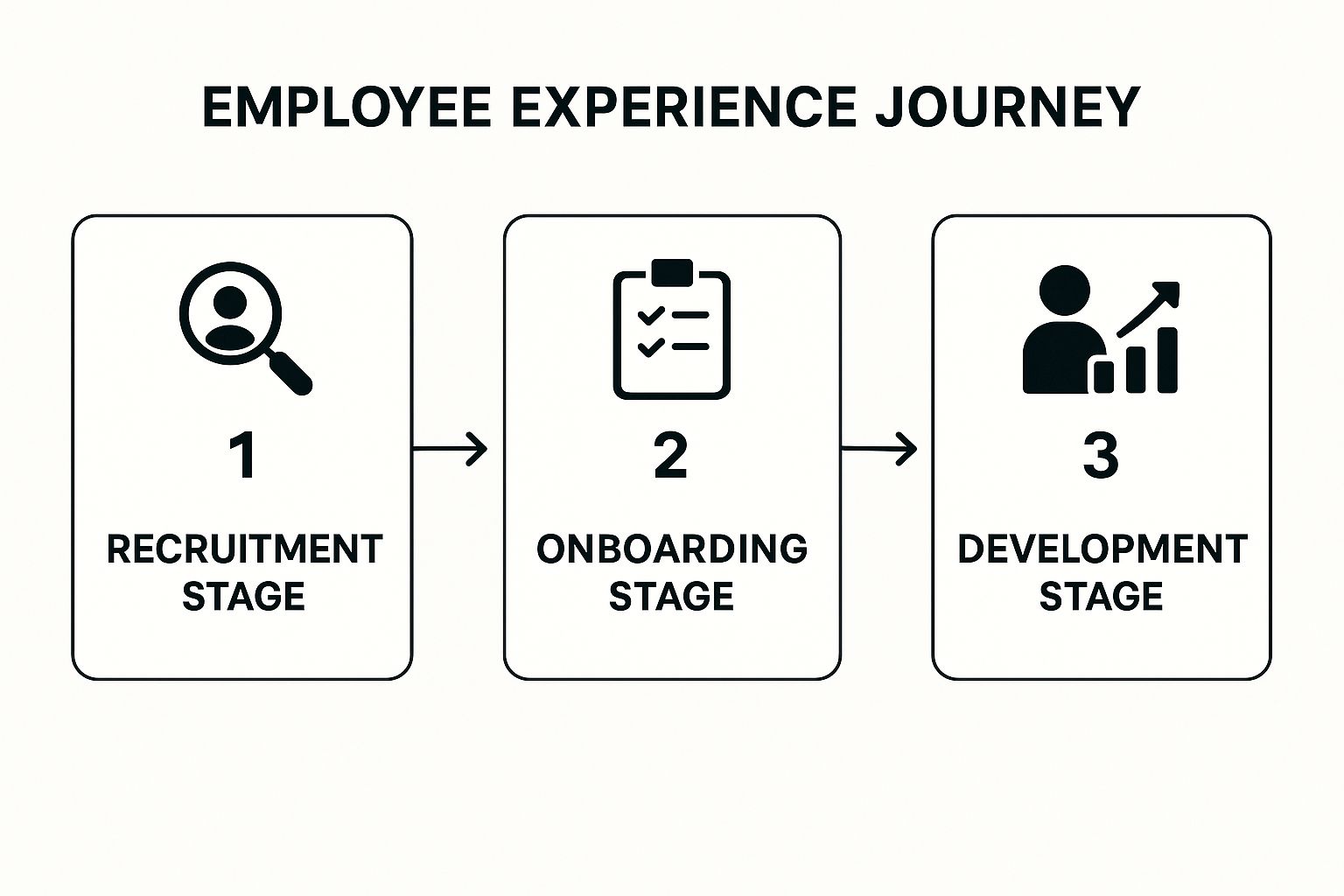Understanding the Power of Employee Satisfaction Surveys
Want to build a thriving workplace? This listicle provides eight practical employee satisfaction survey examples to help you gather crucial insights from your team. Learn how to use formats like Likert scales, eNPS, pulse surveys, open-ended questions, 360-degree feedback, Employee Satisfaction Index (ESI), stay interviews, and employee journey mapping. These employee satisfaction survey examples empower you to improve workplace culture and boost engagement. Discover the format that best suits your needs and start building a better employee experience.
1. Likert Scale Survey Format
When it comes to gathering quantifiable data on employee satisfaction, the Likert Scale reigns supreme. This incredibly versatile and widely used format empowers you to gauge employee sentiment on a range of workplace aspects, offering a clear snapshot of your organization's overall health. The Likert Scale presents employees with statements and asks them to rate their level of agreement on a numerical scale, typically ranging from 1 to 5 or 1 to 7. This simple yet powerful approach provides data that can be easily analyzed, tracked, and compared across different teams, departments, or even across different time periods. Unlock the potential of data-driven decisions to foster a thriving and fulfilling work environment for your employees.

The Likert Scale format deserves its top spot on our list of employee satisfaction survey examples for several reasons. Its simplicity and ease of use contribute to high completion rates, providing you with valuable data from a larger pool of respondents. This format also allows for statistical analysis, empowering you to identify trends, pinpoint areas for improvement, and measure the impact of implemented changes. The ability to compare results across departments or over time enables you to track progress and ensure that your initiatives are effectively enhancing employee satisfaction.
Features and Benefits:
- Typically uses 5-point or 7-point scales: This offers a good balance between detail and simplicity.
- Ranges from 'Strongly Disagree' to 'Strongly Agree': Provides clear options for respondents to express their opinions.
- Easily quantifiable results: Facilitates statistical analysis and reporting.
- Can cover multiple aspects of workplace satisfaction: From work-life balance to leadership effectiveness, the Likert Scale can capture a holistic view of employee experiences.
Pros:
- Simple for respondents to understand and complete.
- Provides numerical data for statistical analysis.
- Allows for easy comparison between departments or over time.
- High completion rates due to ease of use.
Cons:
- May lead to central tendency bias (respondents avoiding extreme options).
- Limited depth of insights compared to open-ended questions.
- Can be subject to acquiescence bias (tendency to agree).
- May not capture nuanced feedback.
Examples of Successful Implementation:
- Gallup's Q12 Employee Engagement Survey: A renowned survey that uses the Likert Scale to measure employee engagement across various dimensions.
- SurveyMonkey's Employee Satisfaction Template: Offers pre-built Likert Scale questions to streamline the survey creation process.
- Google's annual Googlegeist employee survey: A comprehensive internal survey that utilizes the Likert Scale to gather feedback on a wide range of topics.
Actionable Tips for Implementation:
- Balance positively and negatively worded questions: This helps reduce bias and ensures a more accurate representation of employee sentiment.
- Include a neutral midpoint option when appropriate: Allows respondents to express a neutral stance when they neither agree nor disagree.
- Keep the scale consistent throughout the survey: This promotes clarity and reduces confusion for respondents.
- Consider adding comment fields after key questions: Provides an opportunity for respondents to elaborate on their ratings and provide more nuanced feedback.
When and Why to Use This Approach:
The Likert Scale survey format is ideal when you need to collect quantifiable data on employee satisfaction across various areas. It is particularly effective for tracking progress over time, comparing results across departments, and identifying areas that require attention. Use this approach when you want to:
- Measure employee satisfaction with specific aspects of the workplace.
- Track changes in employee satisfaction over time.
- Compare satisfaction levels across different teams or departments.
- Identify key drivers of employee satisfaction and dissatisfaction.
By leveraging the power of the Likert Scale format, you can gain invaluable insights into your employees' experiences and create a workplace where everyone thrives.
2. eNPS (Employee Net Promoter Score) Format
The eNPS (Employee Net Promoter Score) is a powerful and increasingly popular method for gauging employee loyalty and satisfaction, earning its spot on this list of top employee satisfaction survey examples. Adapted from the customer-focused Net Promoter Score, its elegant simplicity makes it a valuable tool for organizations of all sizes. It centers around a single, yet impactful question: "On a scale of 0-10, how likely are you to recommend this company as a place to work?" This straightforward approach makes it incredibly easy to implement and understand, encouraging higher response rates and providing a clear, trackable metric.
How it Works:
The eNPS survey categorizes employees into three distinct groups based on their responses:
- Promoters (9-10): These are your enthusiastic employees, your brand ambassadors. They are highly engaged, loyal, and likely to speak positively about your company. They are the driving force behind positive growth and a thriving work environment.
- Passives (7-8): These employees are generally satisfied but not overly enthusiastic. They are susceptible to being swayed by competitors and may not actively promote your company. Understanding their perspective is key to nurturing their satisfaction and converting them into promoters.
- Detractors (0-6): These employees are dissatisfied and potentially disengaged. They may be actively spreading negative word-of-mouth, impacting your employer brand and potentially hindering productivity and innovation. Addressing their concerns is crucial for improving overall employee morale and retention.
The final eNPS score is calculated by subtracting the percentage of detractors from the percentage of promoters, resulting in a score ranging from -100 to +100. A higher score indicates a stronger workforce sentiment and a greater likelihood of employee referrals and positive word-of-mouth.
Features and Benefits:
- Simplicity: The single-question format makes it quick and easy for employees to complete, leading to higher participation rates.
- Clear Metric: The eNPS produces a single, easily digestible score that can be tracked over time, allowing you to monitor progress and identify trends.
- Benchmarking: eNPS scores can be compared against industry benchmarks, providing valuable context and insights into your company's performance relative to competitors.
- Actionable Insights (with follow-up): While the initial score provides a high-level overview, the crucial element lies in the follow-up question: "Why did you give that score?" This qualitative data provides invaluable context, revealing the specific drivers of employee sentiment and highlighting areas for improvement.
Pros:
- Quick to complete, leading to higher response rates
- Easy to understand and implement
- Produces a single, comparable metric
- Can be benchmarked against industry standards
Cons:
- Overly simplistic; doesn't identify specific issues without follow-up questions
- Requires follow-up questions to gain actionable insights
- May fluctuate based on recent events rather than overall, long-term satisfaction
- Cultural differences can affect scoring tendencies
Examples of Successful Implementation:
Industry giants like Apple, Microsoft, and Salesforce utilize eNPS as part of their internal employee satisfaction tracking and culture assessments. These companies understand the value of regularly monitoring employee sentiment and using the insights to drive positive change.
Actionable Tips for Implementation:
- Always include a follow-up question: Asking "Why did you give that score?" is essential for gaining actionable insights and understanding the drivers behind the numbers.
- Conduct regularly (e.g., quarterly): Tracking eNPS over time allows you to identify trends, measure the impact of initiatives, and proactively address emerging issues.
- Segment results: Analyze results by department, tenure, location, etc. for a deeper understanding of employee sentiment within specific groups.
- Combine with other methods: While eNPS is a valuable tool, it’s most effective when used in conjunction with more comprehensive surveys and feedback mechanisms for a more holistic understanding of employee satisfaction.
Why eNPS Deserves its Place:
The eNPS is a valuable addition to any HR professional's toolkit because it provides a simple yet effective way to measure employee loyalty and identify potential issues. Its ease of implementation, clear metric, and ability to be tracked over time make it a powerful tool for driving positive change and creating a more engaged and productive workforce. By taking advantage of the eNPS, organizations can gain a crucial understanding of employee sentiment and take proactive steps towards building a thriving workplace culture.
3. Pulse Survey Format
The Pulse Survey Format earns its place on this list of top employee satisfaction survey examples due to its ability to provide real-time insights into the heartbeat of your organization. These short, frequent surveys, typically containing 5-15 questions, offer a dynamic approach to understanding employee sentiment. Unlike lengthy annual surveys, pulse surveys focus on specific areas of employee satisfaction or engagement, allowing you to quickly identify and address emerging issues, fostering a culture of continuous improvement. They work by gathering frequent, focused feedback, providing a constant stream of data that paints a clear picture of employee experience.

Pulse surveys are characterized by their brevity and high frequency. They are often administered weekly, monthly, or quarterly, depending on the specific needs of the organization. They are generally focused on particular themes or topics, allowing for deeper dives into specific areas like work-life balance, management effectiveness, or team dynamics. These surveys are frequently delivered through convenient channels like mobile apps or email, making participation easy and accessible for employees.
Features:
- Brief: Typically 5-15 questions, respecting employees’ time.
- High Frequency: Weekly, monthly, or quarterly, providing continuous feedback.
- Focused: Concentrates on specific topics or themes for targeted insights.
- Accessible: Often delivered via mobile apps or email for ease of use.
Pros:
- Real-time feedback and trend data: Stay ahead of the curve by identifying emerging trends as they happen.
- Higher response rates due to brevity: Short surveys encourage greater participation and provide more comprehensive data.
- Agile response to emerging issues: Address concerns promptly and prevent them from escalating.
- Demonstrates organizational commitment to ongoing feedback: Show your employees that their voices are valued and heard.
Cons:
- Survey fatigue if overused: Strike a balance to avoid overwhelming employees with too many surveys.
- Limited scope compared to comprehensive surveys: May not capture the full breadth of employee experience as effectively as broader annual surveys.
- Requires robust analytics to interpret trends: Effective data analysis is crucial to extract meaningful insights.
- May miss systemic issues that require deeper investigation: While pulse surveys can highlight surface issues, deeper investigations may be required to uncover underlying systemic challenges.
Examples of Successful Implementation:
- Culture Amp: Known for its weekly pulse surveys that help organizations track employee engagement and sentiment.
- LinkedIn's Glint: A powerful pulse survey platform offering customizable templates and advanced analytics.
- Qualtrics Employee Experience: Provides robust pulse survey tools with features like real-time reporting and action planning.
Actionable Tips for Readers:
- Rotate question sets: Cover different topics while keeping surveys short and engaging.
- Ensure quick follow-up actions: Demonstrate responsiveness by addressing identified issues promptly.
- Communicate results and actions transparently: Share key findings and actions taken with employees to build trust and foster open communication.
- Use consistent core questions: Track trends over time and measure the effectiveness of interventions.
When and Why to Use this Approach:
Pulse surveys are particularly valuable when you need quick, frequent insights into specific aspects of employee experience. They are ideal for tracking progress on key initiatives, gauging the impact of organizational changes, or monitoring team morale. Implementing pulse surveys showcases a commitment to continuous improvement and allows for proactive interventions to boost employee satisfaction and engagement. This approach empowers organizations to stay agile, adapt to change, and create a thriving work environment. While further resources on specific platforms can be found online (like Culture Amp, TINYpulse, and 15Five), these examples showcase the power and impact of implementing pulse surveys for maximizing employee satisfaction.
4. Open-Ended Question Format
Unlock the true depth of your employees' experiences with the power of open-ended questions in your employee satisfaction surveys. This approach, a vital component of robust employee satisfaction survey examples, shifts the focus from pre-defined answers to rich, qualitative data, providing a window into the hearts and minds of your workforce. Instead of ticking boxes, employees articulate their thoughts and feelings in their own words, painting a vivid picture of their workplace reality. This makes open-ended questions an invaluable tool for any HR professional seeking authentic and actionable feedback.
How It Works: Giving a Voice to Your Employees
Open-ended questions invite narrative responses, allowing employees to express themselves freely. Instead of limiting them to a set of predetermined options, you're empowering them to share their unique perspectives. Questions like "What would improve your job satisfaction?" or "Describe our company culture in your own words" encourage thoughtful reflection and unfiltered feedback. This format allows you to explore the "why" behind employee sentiment, uncovering valuable insights that might be missed with structured questionnaires.
Features that Empower Authentic Feedback:
- No Predetermined Responses: Employees aren't confined to restrictive choices, enabling more nuanced and personalized responses.
- Free-Form Text Boxes: These provide the space for employees to elaborate and provide context to their thoughts and feelings.
- Qualitative Focus: The emphasis is on understanding the richness and depth of employee experiences, rather than simply quantifying them.
- Combination with Structured Questions: While open-ended questions are powerful, they are often most effective when used in conjunction with some structured questions to provide context and quantifiable data.
Pros: Unveiling Hidden Gems of Insight:
- Rich, Detailed Feedback: Go beyond surface-level responses and gain a deeper understanding of employee perspectives.
- Unexpected Insights: Discover hidden issues, unmet needs, and innovative ideas that you might not have anticipated.
- Specific Examples and Suggestions: Employees can provide concrete examples and actionable suggestions for improvement.
- Uncover Hidden Issues: Surface concerns and challenges that might not be captured in structured questions.
Cons: Navigating the Nuances of Qualitative Data:
- Time-Consuming Analysis: Analyzing qualitative data requires careful reading and interpretation, which can be time-intensive.
- Lower Completion Rates: Open-ended questions require more effort from respondents, potentially leading to lower survey completion rates.
- Subjective Interpretation: Analysis can be subjective and requires skilled researchers to identify patterns and themes.
- Difficult to Quantify: Comparing and quantifying qualitative data can be challenging.
Examples of Open-Ended Questions in Action:
Companies like Shopify (with their 'State of Work' survey), Buffer (known for their transparent culture surveys), and Atlassian (utilizing the 'Team Health Monitor') have effectively incorporated open-ended questions into their employee satisfaction surveys. While specific links may not be publicly available for these internal surveys, their success highlights the value of this approach.
Actionable Tips for Success:
- Limit the Number of Open-Ended Questions: Avoid survey fatigue by strategically selecting a few key questions.
- Utilize Text Analysis Software: Tools can help identify common themes and sentiments within the responses.
- Strategic Placement: Position open-ended questions after related structured questions to provide context.
- Adequate Response Space: Ensure enough space for employees to express themselves thoroughly.
- Consider Anonymity: Encourage honest and candid feedback by offering anonymous responses.
Why Open-Ended Questions Deserve Their Place:
Open-ended questions are indispensable for gaining a truly holistic understanding of employee satisfaction. They empower your workforce, uncover hidden opportunities, and provide the rich qualitative data necessary to drive meaningful change. This makes them an essential tool for aspiring HR professionals, experienced HR specialists, educational institutions, corporate HR teams, and the global HR community alike, allowing them to create truly impactful employee satisfaction surveys. By incorporating this approach, you're not just collecting data; you're building a bridge to a more engaged, satisfied, and productive workforce.
5. 360-Degree Feedback Survey Format
Looking for a powerful way to boost employee satisfaction and cultivate a thriving workplace? The 360-degree feedback survey format offers a dynamic approach to gathering insights from multiple perspectives, painting a comprehensive picture of an employee's performance and experience within the organization. This method goes beyond traditional top-down evaluations by incorporating feedback from managers, peers, direct reports, and even a self-assessment from the employee themselves. While often utilized for performance reviews, the 360-degree feedback method also offers valuable insights into employee satisfaction, helping organizations understand the complex dynamics at play and identify key factors influencing happiness and engagement.

This multi-source feedback system blends quantitative ratings with qualitative comments, providing a richer, more nuanced understanding of an individual's contributions and how they are perceived within the team. This holistic approach allows for a deeper exploration of satisfaction levels related to team dynamics, leadership effectiveness, and overall workplace culture. It's a powerful tool that deserves its place on this list of employee satisfaction survey examples because it offers a unique opportunity to identify discrepancies between self-perception and the views of others, ultimately fostering self-awareness and growth. For example, an employee might rate their communication skills highly, while feedback from colleagues reveals areas for improvement. These insights can then be used to create targeted development plans and promote a culture of continuous improvement.
Companies like Deloitte, Google, and General Electric have successfully implemented variations of the 360-degree feedback process, showcasing its effectiveness in driving positive change. Deloitte's performance management system, Google's upward feedback program for managers, and General Electric's leadership assessment process (popularized by former CEO Jack Welch) are prime examples of how this method can be tailored to meet specific organizational needs. These examples highlight how 360-degree feedback can be a catalyst for improving leadership effectiveness, fostering collaboration, and ultimately, increasing employee satisfaction.
Features and Benefits:
- Multi-source feedback: Gain a well-rounded perspective.
- Self-assessment: Encourages reflection and self-awareness.
- Insights into team dynamics and leadership: Identifies strengths and weaknesses.
- Quantitative and qualitative data: Provides a comprehensive understanding.
- Promotes open feedback: Fosters a culture of communication and growth.
Pros:
- Holistic view of workplace satisfaction and dynamics.
- Identifies discrepancies in self-perception.
- Uncovers leadership and collaboration issues.
- Promotes a culture of open feedback.
Cons:
- Complex to implement and administer.
- Potential for anxiety if not managed properly.
- Requires significant time investment.
- May overemphasize performance over satisfaction.
Actionable Tips for Implementation:
- Ensure anonymity: Encourage honest and open feedback.
- Separate development from evaluation: Focus on growth, not judgment.
- Train participants: Equip them with the skills to provide constructive feedback.
- Include specific satisfaction questions: Target key areas like management and team dynamics.
- Follow up with action plans: Turn insights into tangible improvements.
By following these tips and adapting the 360-degree feedback process to your organization's unique context, you can leverage this powerful tool to unlock the full potential of your workforce, foster a more positive and engaging work environment, and ultimately, drive significant improvements in employee satisfaction. This method, pioneered by thought leaders like Jack Welch and organizations like Development Dimensions International (DDI) and the Center for Creative Leadership, provides a valuable framework for creating a more fulfilling and productive workplace for everyone.
6. Employee Satisfaction Index (ESI) Format
Looking for a scientifically-backed, trackable metric to gauge employee satisfaction? The Employee Satisfaction Index (ESI) format might be just what you need. This standardized survey format offers a powerful way to measure and monitor the heartbeat of your organization, providing valuable insights into your employees' overall well-being. This approach deserves a place on this list because of its rigorous methodology and ability to provide a clear, concise satisfaction score.
How it Works: The ESI boils down employee satisfaction into three core questions:
- Overall Satisfaction: How satisfied are you with your current workplace?
- Expectation Fulfillment: How well does your current workplace meet your expectations?
- Ideal Workplace Comparison: How does your current workplace compare to your ideal workplace?
Employees respond to these questions using a 10-point scale. These responses are then processed through a specific formula to generate an index score on a 0-100 scale. This single, quantifiable metric makes it incredibly easy to track progress over time and identify areas for improvement within your organization.
Examples of ESI in Action: The ESI format finds its roots in established methodologies like the Swedish Quality Index (SQI) for employee satisfaction measurements and the European Performance Satisfaction Index (EPSI) for workplace studies. Even the widely recognized American Customer Satisfaction Index (ACSI) methodology can be adapted and applied to employee satisfaction. These examples demonstrate the versatility and adaptability of the ESI approach across various contexts.
Actionable Tips for Implementation:
- Consistency is Key: Use the core ESI questions consistently over time to accurately track trends and measure the impact of implemented changes.
- Dive Deeper: Supplement the core questions with rotating, topic-specific questions to uncover the drivers behind the overall satisfaction score. This provides actionable insights for targeted improvements.
- Segment for Granular Insights: Break down the results by department, tenure, role, and other relevant demographics to identify specific areas of strength and weakness within your organization.
- Benchmark for Best Practices: Whenever possible, compare your ESI score against industry benchmarks to understand how your organization stacks up against competitors.
- Transparent Communication: Clearly communicate the ESI score and its meaning to stakeholders, fostering a culture of open communication and shared understanding.
Pros:
- Scientifically Validated: The ESI methodology is based on robust research, providing a statistically significant measure of employee satisfaction.
- Trackable Metric: The 0-100 index makes it easy to track progress and demonstrate the impact of initiatives.
- Benchmarking Capabilities: Allows for comparison against industry standards, providing valuable context for your results.
- Simplicity and Significance: Easy to administer while yielding statistically significant results.
Cons:
- Lack of Specificity: The core ESI questions alone don't provide detailed insights into the causes of satisfaction or dissatisfaction.
- Need for Supplemental Questions: Requires additional, targeted questions to generate actionable insights.
- Oversimplification Risk: May oversimplify complex workplace dynamics by focusing on a single metric.
- Benchmarking Challenges: Less common than other formats, which can make industry benchmarking more difficult.
When to Use ESI: The ESI is particularly useful when you need a concise, trackable metric to monitor overall employee satisfaction trends over time. It's ideal for organizations seeking a scientifically validated approach to measure the impact of workplace initiatives and compare their performance against industry standards. As an aspiring HR professional, understanding and utilizing the ESI can significantly enhance your ability to drive positive change and foster a thriving workplace environment. For experienced HR specialists, the ESI offers a standardized framework to validate and strengthen existing employee satisfaction programs. This approach provides educational institutions, corporate HR teams, and the global HR community with a powerful tool to advance the study and practice of effective human resource management. This powerful tool empowers you to create a more engaged, productive, and fulfilling work environment for all.
7. Stay Interview Format
Looking for impactful employee satisfaction survey examples? Look no further than the stay interview format. This proactive approach offers a powerful way to understand what truly motivates your employees and identify potential retention risks before they escalate into departures. Unlike exit interviews, which offer insights after the horse has left the barn, stay interviews provide valuable, real-time feedback while you still have the opportunity to make a difference. This makes it a crucial addition to any comprehensive employee satisfaction strategy.
Stay interviews are structured conversations or surveys designed to explore the reasons why employees choose to stay with your organization and what factors might tempt them to leave. They delve into the heart of employee satisfaction, uncovering the aspects of their work experience that resonate most strongly and identifying any pain points that could lead to disengagement. This proactive approach empowers organizations to address potential issues, cultivate a more positive work environment, and ultimately, retain their valuable talent.
How Stay Interviews Work:
Stay interviews typically involve a series of 5-10 open-ended questions that encourage employees to share their perspectives openly. These can be conducted as in-person interviews, fostering a more personal connection, or through written surveys, offering a sense of anonymity. The focus remains consistent: understanding retention factors and identifying improvement opportunities. Often, these conversations are facilitated by direct managers with their team members, strengthening the manager-employee relationship and fostering open communication.
Features of a Successful Stay Interview:
- Open-ended Questions: Phrased to encourage thoughtful responses and avoid simple "yes" or "no" answers.
- Focus on Retention: Questions explore what employees value, what might cause them to leave, and what the organization can do better.
- Flexibility in Format: Adaptable to both in-person discussions and written questionnaires.
- Manager-Led: Ideally conducted by direct managers to build rapport and trust.
Pros:
- Proactive Retention: Address potential issues before they lead to turnover.
- Trust Building: Fosters open communication and stronger manager-employee relationships.
- Actionable Feedback: Provides specific insights into areas for improvement.
- Demonstrates Investment: Shows employees that the organization cares about their well-being.
Cons:
- Time Intensive: In-person interviews can require significant time commitment.
- Interviewer Skill: Requires trained interviewers or carefully crafted survey questions.
- Confidentiality Concerns: Employees may hesitate to share honest feedback if they fear repercussions.
- Requires Follow-Up: Must be followed by visible action to maintain credibility and demonstrate commitment.
Examples of Successful Implementation:
Several organizations have embraced stay interviews as a key component of their retention strategies. Cisco's manager-led stay interview program, Marriott's associate retention initiative, and IBM's manager toolkit for retention conversations are prime examples of how this approach can be implemented effectively. These companies have recognized the value of proactively engaging with their employees to understand their needs and create a more fulfilling work experience.
Actionable Tips for Implementing Stay Interviews:
- Train Managers: Equip managers with the skills to conduct effective and empathetic stay interviews.
- Schedule Regularly: Implement regular stay interviews (at least annually) to track trends and identify emerging issues.
- Psychological Safety: Create a safe and trusting environment where employees feel comfortable sharing honest feedback.
- Individualized Plans: Develop personalized retention plans based on the feedback received.
- Track Common Themes: Analyze responses across multiple interviews to identify systemic issues and implement broader organizational changes.
Popularized By:
The power of stay interviews has been championed by experts like Beverly Kaye (author of 'Love 'Em or Lose 'Em') and Richard Finnegan (author of 'The Power of Stay Interviews'), as well as organizations like the Society for Human Resource Management (SHRM). Their work has highlighted the significant impact that this simple yet effective tool can have on employee satisfaction and retention.
By incorporating stay interviews into your employee satisfaction survey repertoire, you demonstrate a commitment to understanding and addressing the needs of your workforce. This proactive approach empowers you to create a more engaging and fulfilling work environment, ultimately leading to increased retention and a more thriving organization. This makes it a valuable tool for aspiring HR Professionals, Experienced HR Specialists, Educational Institutions, Corporate HR Teams, and the Global HR Community alike, seeking effective employee satisfaction survey examples.
8. Employee Experience Journey Mapping Format
Want to understand the entire employee experience, from the moment they first hear about your company to the day they move on? Employee Experience Journey Mapping is an innovative format among employee satisfaction survey examples that does just that. This powerful approach adapts customer journey mapping techniques to the employee lifecycle, providing a holistic view of employee satisfaction across all stages. It goes beyond traditional surveys by capturing both quantitative ratings and qualitative feedback, focusing on the crucial 'moments that matter' throughout an employee's time with your organization. This approach allows you to truly understand the emotional highs and lows of your employees' experiences.

The infographic above visualizes the cyclical nature of employee experience, emphasizing continuous improvement. It highlights the key stages: Attract, Recruit, Onboard, Engage, Develop, Perform, Exit, and the importance of feedback loops throughout the entire journey. By analyzing the touchpoints within each stage, you can pinpoint crucial areas for improvement and enhance the overall employee experience.
This method is more than just another survey—it’s a strategic tool for creating a workplace where employees thrive. By understanding the complete employee journey, you can pinpoint specific areas for improvement, boost engagement, and ultimately create a more positive and productive work environment.
The Employee Experience Journey Mapping process typically follows these steps:
- Identify Key Touchpoints: Determine the critical interactions employees have with the organization throughout their lifecycle. This might include applying for a job, the first day of work, performance reviews, training opportunities, and exit interviews.
- Gather Data: Collect both quantitative (e.g., satisfaction ratings) and qualitative (e.g., open-ended feedback) data at each touchpoint.
- Visualize the Journey: Plot the data on a journey map, visually representing the employee experience across different stages. High and low points in satisfaction and emotional response become readily apparent.
- Analyze and Prioritize: Identify pain points and areas for improvement based on the data collected. Prioritize these areas based on their potential impact on the employee experience.
- Implement Changes and Measure Impact: Develop and implement targeted interventions to address identified pain points. Continuously monitor the impact of these changes on employee satisfaction.
The sequential nature of this process is crucial because each step builds upon the previous one. Without identifying key touchpoints, you can't effectively gather relevant data. Without visualizing the journey, you can't easily identify pain points. This structured approach ensures a comprehensive and actionable analysis of the employee experience.
Features:
- Maps satisfaction across all employee lifecycle stages
- Identifies critical ‘moments that matter’
- Combines satisfaction ratings with emotional response data
- Often visualized as a journey map highlighting high and low points
Pros:
- Provides a holistic view of the employee experience
- Identifies specific pain points and moments of delight
- Helps prioritize improvement efforts based on impact
- Aligns with modern employee experience management approaches
Cons:
- More complex to design and analyze than traditional surveys
- Requires input from employees at different stages
- May be challenging to quantify for statistical analysis
- Relatively new approach with fewer established benchmarks
Examples: IBM's Employee Experience Index, Airbnb's employee journey mapping initiative, ServiceNow's Employee Experience Mapping toolkit.
Tips for Implementation:
- Identify 15-20 key touchpoints across the employee lifecycle.
- Use a mix of satisfaction ratings and emotional response questions.
- Include open text fields for specific suggestions at each touchpoint.
- Visualize results as a journey map showcasing high and low points.
- Create cross-functional teams to address pain points.
This method deserves its place in this list of employee satisfaction survey examples because it provides a dynamic and comprehensive understanding of the employee experience. Pioneered by thought leaders like Jacob Morgan, Josh Bersin, and McKinsey & Company, it's an innovative approach to enhancing the employee journey. It offers a powerful way for aspiring HR professionals, experienced specialists, educational institutions, corporate HR teams, and the global HR community to build a more engaged and fulfilling workplace.
Employee Satisfaction Survey Formats Comparison
| Format | Implementation Complexity 🔄 | Resource Requirements 🔄 | Expected Outcomes 📊 | Ideal Use Cases 💡 | Key Advantages ⭐ |
|---|---|---|---|---|---|
| Likert Scale Survey Format | Low – straightforward design and analysis | Low – simple to deploy and quantify | Quantifiable data, trend analysis | Broad employee satisfaction measurement | Easy to understand, high completion rates |
| eNPS (Employee Net Promoter Score) Format | Very low – single question with simple scoring | Minimal – very short and easy to administer | Clear metric of loyalty, easy benchmarking | Quick pulse on employee loyalty and engagement | Fast completion, simple, benchmarkable |
| Pulse Survey Format | Medium – frequent deployment with focus | Moderate – needs regular administration | Real-time feedback and trend spotting | Agile monitoring of employee sentiment | Short, frequent, high response rates |
| Open-Ended Question Format | Medium to High – qualitative data requires effort | High – time-intensive for analysis | Deep, rich insights and unexpected feedback | Exploring detailed opinions and improvement ideas | Captures nuanced feedback, qualitative richness |
| 360-Degree Feedback Survey Format | High – multi-source coordination and management | High – involves multiple raters and training | Holistic view of performance and satisfaction | Leadership assessment and team dynamics insights | Comprehensive, multi-perspective feedback |
| Employee Satisfaction Index (ESI) Format | Medium – uses validated formula and core questions | Moderate – requires consistent data collection | Scientifically validated satisfaction index | Standardized satisfaction tracking across orgs | Scientifically robust, trackable metric |
| Stay Interview Format | Medium to High – requires skilled interviewers | Moderate to High – time-intensive if interviews | Actionable retention insights | Retention risk identification and trust building | Proactive retention, personalized feedback |
| Employee Experience Journey Mapping Format | High – complex design and mixed methods | High – multiple stages and data types | Holistic lifecycle satisfaction and pain points | Comprehensive employee experience management | Identifies critical moments, visual insights |
Taking Action: Turning Insights into Improvement
From Likert scales and eNPS to pulse surveys and 360-degree feedback, this article has explored a range of employee satisfaction survey examples, each offering unique insights into your workforce. Mastering these different formats empowers you to gather comprehensive feedback, understand employee perspectives, and ultimately create a workplace where everyone thrives. Key takeaways include understanding the strengths and weaknesses of each survey type, tailoring your approach to specific objectives, and prioritizing actionable questions that drive meaningful change.
When designing your employee satisfaction surveys, it's essential to consider best practices for form design to ensure high completion rates and gather accurate data. For practical tips on creating effective forms, explore these form design best practices. Remember, choosing the right employee satisfaction survey examples is just the first step. The real magic happens when you analyze the data and translate those insights into tangible improvements. By actively listening to your employees and addressing their concerns, you’re not just building a better workplace – you're fostering a culture of trust, respect, and shared success.
Taking action based on your survey results is the most crucial step in improving employee satisfaction. This might involve implementing new policies, refining existing processes, or simply acknowledging and addressing employee concerns. By demonstrating that you value employee feedback, you create a positive feedback loop that encourages open communication and continuous improvement.
Ready to take your HR strategies to the next level and transform your workplace into a thriving hub of engagement and productivity? The Global Human Resource Institute offers valuable resources and certifications specializing in data interpretation and action planning related to employee satisfaction survey examples. Visit the Global Human Resource Institute to learn more and unlock the full potential of your workforce.




0 Comments